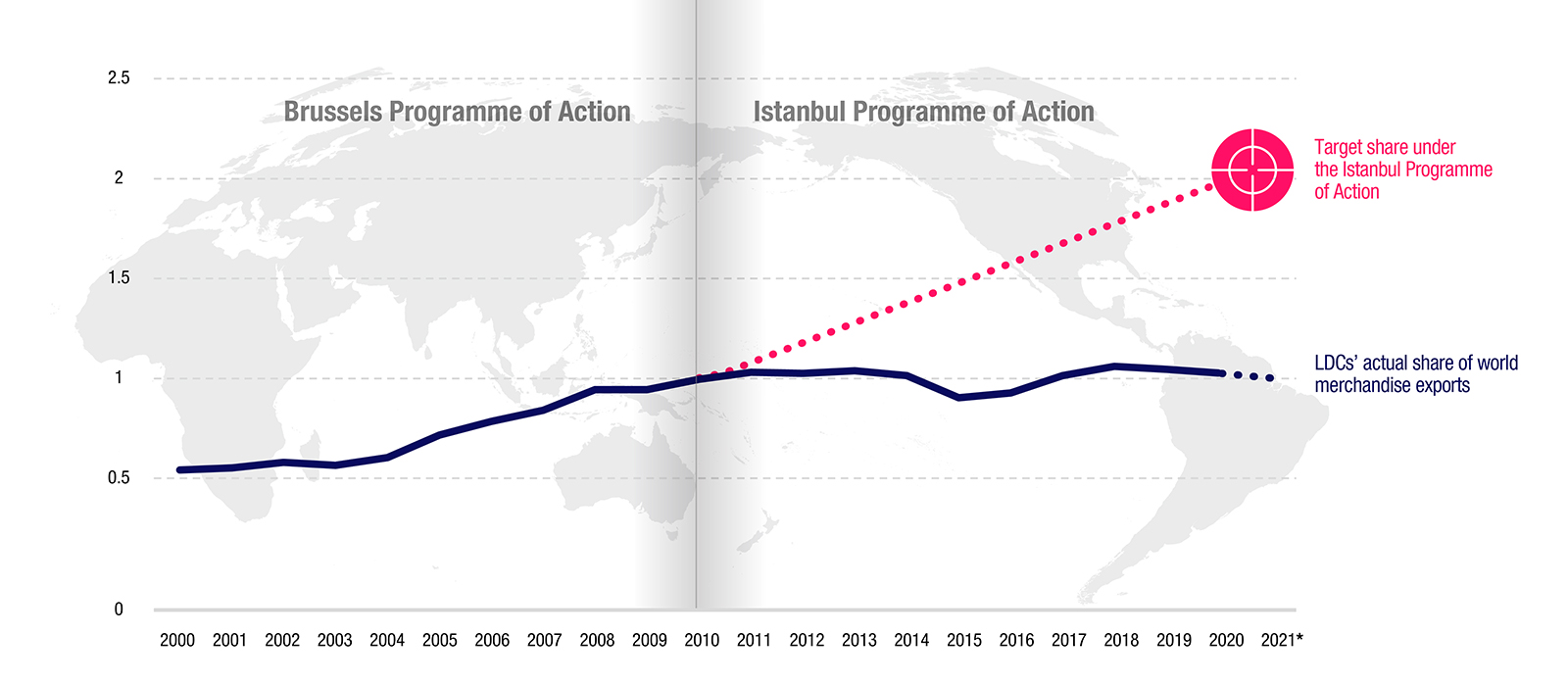Developing countries account for 45% of world trade but least developed countries remain on the margins.

Source: UNCTAD secretariat calculations based on data from UNCTADstat database.
Notes: * Data for 2021 are preliminary forecasts. In the scenario consistent with the Istanbul Programme of Action (IPoA) target, the increase in LDCs’ share of global exports is computed on a linear basis.
In 2011, through the Istanbul Programme of Action (IPoA) for least developed countries (LDCs), the international community reemphasized the importance of trade for sustainable growth and development, and committed to boost LDCs’ role in international trade.
More specifically, under IPoA, the world pledged to double the share of LDCs’ exports in global exports to approximately 2% by 2020, including by broadening these countries’ export base. The same objective was reaffirmed in 2015 in the UN’s Sustainable Development Goal 17.
While LDCs doubled their share of world exports from 0.55 % to 1.03% between 2001 and 2010, the term of the Brussels Programme of Action (BPoA), mainly due to a surge in commodity prices, their share of global merchandise exports has hovered around a mere 1% since 2010, as the above chart shows. Therefore, the IPoA target failed to materialize even before the COVID-19 pandemic hit.
Situation may get worse in 2021
The situation is unlikely to change soon, despite improvements in prices of commodities, which drive the exports of many LDCs. Recent UNCTAD research shows that the ongoing rebound in international trade flows appears to be relatively weaker in LDCs, fuelling fears that LDCs’ export share may decline in 2021 and that the long-term effects of the COVID-19 pandemic will likely be felt for years to come.
Regardless of whether the IPoA target is taken literally – by comparing progress between 2011 and 2020 – or pre-COVID-19 trends are considered, fewer than a quarter of the 46 LDCs appear to be on course to double their export share.
Similarly, while several LDCs have broadened their export base, as many as 38 of them remain commodity dependent, relying on primary commodities for over 60% of their merchandise exports. High dependence on commodities’ exports makes most LDCs extremely vulnerable to trade shocks. This remains true even for countries that have graduated from the LDC category and moved up in many aspects of human and social development.
More efforts needed to boost LDC exports
Against this background and with the 5th UN Conference on LDCs (LDC5) in sight to chart the next programme of action for LDCs, the international community needs to redouble its efforts to boost LDCs’ export capacities. This would form an essential part of these countries’ paths toward a resilient recovery.
UNCTAD has therefore called for a new generation of international support measures (ISMs) more closely aligned to LDCs’ needs and 21st century realities, addressing the root causes of the current limited productive capacities in these countries.
These should include facilitating the accession of LDCs to the World Trade Organization, promoting compliance with rules of origin (by ensuring preferential rules of origin are transparent, simple and promote market access) and tackling pervasive non-tariff barriers faced by LDC exporters.
The measures should also entail supporting LDCs in leveraging emerging opportunities from regional and sub-regional integration, notably from the African Continental Free Trade Area, for example by promoting trade facilitation projects in African LDCs to help women, young people and small businesses connect to global markets, including to global value chains.
Broader efforts are also required to enhance the capacity and quality of national institutions in LDCs, hence improving their ability to set priorities right, harness and utilize existing ISMs effectively.
Fundamentally, the development of LDCs’ productive capacities remains a necessary condition for their meaningful participation in international trade and should thus be a key policy priority, to which trade policies and international support should be aligned.
Downloads:
- International trade is back, but not for all by Alessandro Nicita, Ralf Peters and Carlos Razo, UNCTAD
- The State of Commodity Dependence 2021
- The Least Developed Countries Report 2021: The least developed countries in the post-COVID world: Learning from 50 years of experience
- The Least Developed Countries Report 2020: Productive capacities for the new decade
- Economic Development in Africa Report 2019: Made in Africa – Rules of Origin for Enhanced Intra-African Trade


